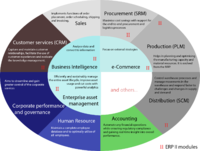
Photo from wikipedia
The study of a marine environment is a challenging task because of the spatio–temporal variations of ocean phenomena and the disturbances caused by ocean currents. As such, we must collect… Click to show full abstract
The study of a marine environment is a challenging task because of the spatio–temporal variations of ocean phenomena and the disturbances caused by ocean currents. As such, we must collect data over long time periods to better assess and understand marine environments. To achieve this, we investigate the long-term trajectories of inexpensive and underactuated drifting vehicles called drifters. These vehicles drift passively with ambient ocean currents. Vertical actuation (buoyancy) enables them to alter their depth and achieve controllability by the use of different current layers in the ocean. We aim to utilize these persistent assets to explore oceanic regions exhaustively; patrolling the surface, covering a 3-D phenomenon (e.g., algal bloom), or examining the seafloor with downward-facing cameras. In this article, we present a data-driven deployment and planning approach for the drifters. We extract the generalized flow pattern within a given region from ocean model predictions, develop a Markov chain-based motion model, and analyze the water flow behavior. Given an initial deployment location of the drifter on the water surface and the flow patterns within the region, our approach finds attractors and their transient groups at different depths as the persistent behavior of the environment. We then determine a minimum number of deployment locations for the drifters using these attractors and their transient groups. All possible reachable locations from the initial deployment location of the drifter are determined as its planned, long-term drifter trajectory based on the computed attractors and transient groups. An optimal navigation policy is developed to demonstrate the best possible action from any location to a goal location in the environment. Our simulation results based on data from ocean model predictions validate the variability in the persistent behavior of the environment and the long-term trajectory of the drifter over space and time. Preliminary results from field trials also validate the practical application of our approach for persistent, large-scale ocean monitoring.
Journal Title: IEEE Journal of Oceanic Engineering
Year Published: 2021
Link to full text (if available)
Share on Social Media: Sign Up to like & get
recommendations!